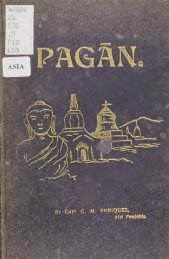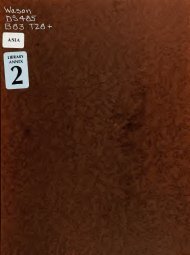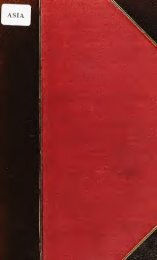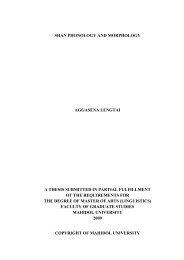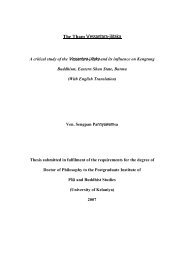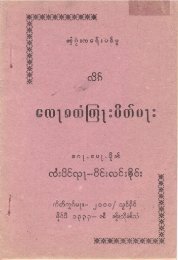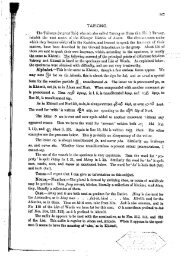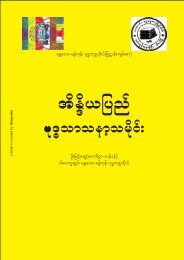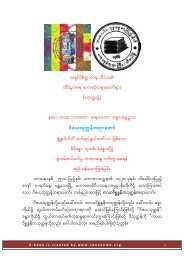The Tai Ahom National Council Memo Scheduling
The Tai Ahom National Council Memo Scheduling
The Tai Ahom National Council Memo Scheduling
You also want an ePaper? Increase the reach of your titles
YUMPU automatically turns print PDFs into web optimized ePapers that Google loves.
Hindu/Hinduized Castes or even Intermediate Castes. (W. W. Hunter, A Statistical Account of<br />
Assam, Vol. I, pp. 236-37)<br />
. In 1901, B.C. Allen, the Census Superintendent, Assam while declining to enlist the <strong>Ahom</strong><br />
as Kshatriya admitted that the <strong>Ahom</strong> are “the aboriginal tribe in Assam”. He writes thus “<strong>The</strong><br />
<strong>Ahom</strong> gentry lay claim to the title of Kshatriya, a claim which, if admitted, would place them<br />
above the Kayastha; but the claims to the title of Kshatriya made by aboriginal tribes in Assam,<br />
can hardly, I think, be taken seriously”(Report on the Census of Assam, 1901, Vol. I, Chapter<br />
XI, p. 118).<br />
In 1926, Sir Edward Gait observed, “<strong>The</strong>y (the <strong>Ahom</strong>) are genuine Shans, both in their<br />
physical type and in their tribal languages and written character”. (A History of Assam, second<br />
edition, 1926, p. 77). In connection with the names of <strong>Ahom</strong> kings and titles of officials, Sir<br />
Edward Gait thus indirectly admitted the <strong>Ahom</strong> as tribal when he writes “<strong>The</strong> tribal names of<br />
the <strong>Ahom</strong> kings usually commenced with Su meaning “tiger”, and ended with pha, meaning<br />
“heaven”…the kings’ Hindu names were often the Assamese equivalents of those given them by<br />
the Deodhais”. (A History of Assam, second edition, pp.244-45).<br />
<strong>The</strong> <strong>Ahom</strong> is not a Dead Language:<br />
<strong>The</strong> <strong>Ahom</strong> language is the original language of the <strong>Ahom</strong>. No doubt in course of time many<br />
<strong>Ahom</strong> adopted the Assamese as their mother tongue, but all records of the early period are made<br />
in the <strong>Ahom</strong> language. Moreover, the <strong>Ahom</strong> priests in the <strong>Ahom</strong> language performed all<br />
religious <strong>Ahom</strong> rites and ceremonies, and they do so even today. <strong>The</strong> <strong>Ahom</strong> priests read and<br />
write, and chant mantras in <strong>Ahom</strong> language on all rites and rituals. <strong>The</strong> view that the <strong>Ahom</strong><br />
language is totally dead is erroneous.<br />
Writing in 1662-63, Shihab-ud-din Talish observes, “<strong>The</strong> language of the <strong>Ahom</strong> differs<br />
entirely from the dialects spoken in Eastern Bengal” which means that all the <strong>Ahom</strong> people<br />
spoke the <strong>Ahom</strong> language till the middle of the seventeenth century A.D.<br />
Chronicles were written in the <strong>Ahom</strong> language till the end of the <strong>Ahom</strong> rule, and the <strong>Ahom</strong><br />
Buranji edited and translated by Golap Chandra Barua is a proof. Land grant copper plates<br />
inscribed in <strong>Ahom</strong> language and issued even by King Chandrakanta Singha (1815-22 A.D.) are<br />
in existence. Moreover, coins continued to be issued in the <strong>Ahom</strong> legends.<br />
<strong>Ahom</strong> Tribal Religious Culture is Distinct from those of non-<strong>Ahom</strong>s of Assam:




